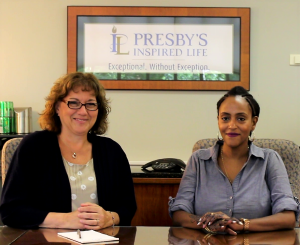
October 24, 2018
This past spring, Director of IT, Karen Reitz and IT Business Systems Analyst, Yordanos Tela of Presby’s Inspired Life were dealing with a major issue for their staff and residents. Whenever they would walk indoors, their cellphones would essentially become inoperable due to the location and construction of their building. If someone had to take or make a call from their cell phone, they had to walk outside.
Karen and Yordanos were referred to HealthSignals by one of their vendors, as wireless experts who have also become a trusted advisor to their clients.
HealthSignals designed a cellular boost system for their Rosemont Campus, providing coverage for all five (5) major carriers throughout their 170,000 Sq. ft campus. The system was designed and installed over a 6-8 week period. After a 3-4 week shakedown period, the HealthSignals team came back to test again, discovered some weak areas and fixed those immediately. HealthSignals continues to monitor and adjust signals and services as needed due to the constantly changing signals levels from the main Carrier Cell Towers.
“(Previously) Every time we walked on campus, all we heard was – No cell service. The project was implemented so successfully that we don’t hear anything (complaints) which is good” said Karen Reitz “I truly believe that they (HealthSignals) feel that our success is their success”.
Yordanos Tela emphasized: “The HealthSignals team was great! They exceeded our expectations, delivered on-time and within budget, and the best part was, no surprises! They worked exceptionally well with our staff and residents, cleaned up daily and made this project very smooth”.
About HealthSignals:
HealthSignals designs, deploys and manages Medical Grade Wi-Fi™ and Cellular Boost Platforms for Senior Living and LTPAC communities. The HealthSignals’ Performance Guarantee provides peace of mind from both a financial and operational perspective. For more information, please email info@healthsignals.net
About Presby’s Inspired Life:
Presby’s Inspired Life is a not-for-profit, faith-based organization that provides continuing care and Affordable Housing for more than 3,000 people 62 and better, across nearly 40 communities throughout greater Philadelphia. https://www.PresbysInspiredLife.org

October 9, 2018
Expectations of residents and families are increasing for tech.
By Bruce Weintraub
The next generation of seniors is moving in. Their adult children are researching the amenities they want for mom and dad, many of which are tech-driven.
Concern is growing over costs and injuries incurred during transport from a skilled nursing facility to and from the hospital or medical offices, making alternatives, such as telemedicine, attractive to residents and their family members alike.
Expectations have changed. Occupancy is down, and your marketing director states that prospects are seeking technology and Internet access like they have at home.
From changing demographics and payment structures to new resident expectations, the senior living executive has significant challenges to address. The reliability of your wireless infrastructure and technology platform should not be one of those worries.
What are the critical factors to ensure your investment in infrastructure results in a worry-free utility — one that can be made “future proof”?
Do’s and Don’ts for Worry-Free Wi-Fi
A successful worry-free Wi-Fi project relies on excellent project management from start to finish. As you plan, manage, and execute your project, keep the following in mind:
- DO engage with cross-functional teams to clearly identify needs from all departments and residents.
- DO engineer the Wi-Fi design using Medical Grade Wireless Utility standards.
- DO plan for the connected health eco-system to support telehealth/telemedicine which includes BYOD (bring your own device) and enabling care outside the hospital system.
- DO design the infrastructure to enable all the capabilities that new residents previously enjoyed such as easy connection of devices, personal network for Chrome-casting, health and environmental monitoring, and wireless printing.
- DO design for the future, not just for today.
- DO staff properly for IT support.
- DO prioritize security. (This should be a key focus!)
- DO address operations concerns.
- DO educate and set expectations with staff and residents.
- DO make current and future device and application decisions based on a well-planned infrastructure platform and DON’T force new infrastructure decisions based on your new applications.
- DON’T approach the project from an IT only perspective.
- DON’T skimp on an inadequate technology architecture.
- DON’T think too small – DO consider ROI models that can increase revenue.
Design for Tomorrow (with Today’s Budget)
Just as your building was designed and built to last for 50 years, your core telecommunications infrastructure should be built for the future as well.
A foundation based on a rock-solid, single mode fiber optic backbone is critical. The core design must accommodate changing business models and technology requirements, many of which have yet to be invented or made commercially viable. Just think: the iPhone’s date of birth was only just in 2007!
With rapidly accelerating change in technology adoption by society, we could see more changes in expectations in the next 5 years as seen in the last 20!
Install the Latest Flexible Tech
Ensure that the wireless solutions you install today are upgradeable via software updates so that you don’t have to replace equipment every three to five years. A quality engineered system should provide up to seven or more years of good service. The fiber in the walls should last a few decades, but client needs will probably prompt an upgrade of the endpoint components in about seven years.
Focus on Integration and Interoperability
Every year, many new products arrive that enhance the senior’s quality of life. These range from telehealth and telemedicine applications, concierge kiosks, and smart wearables for activity monitoring to environmental and security/access control systems.
Most of these enhancements require robust Wi-Fi everywhere a resident, guest, caregiver or administrative staff member goes.
The ability to experiment with and launch these programs in your community depends on whether you have a well-designed Wi-Fi solution.
Eliminate Interference
As the Internet host to all of your residents and staff, you have a responsibility to maintain the highest quality of service. Once you deploy an integrated system that you control, you need to eliminate interfering rogue devices, such as Wi-Fi cable modems, wireless printers, MiFi devices, and many others that can cause channel interference.
Ensure Granularity
Your platform should allow for the customization of all aspects of Wi-Fi service delivery from application blocking to sector prioritization, even down to the individual client device level. BYOD management should make it easy to add or remove transient client devices for visiting doctors, vendors, residents and guests.
Focus on Security
Recent highly publicized breaches like Anthem, Target and Equifax have made us acutely aware of the need to focus on security. Implementing a non-enterprise-grade platform, which may meet your cost expectations, is a mistake for security and other reasons. This area could take up the entire column, but three key concerns to address up front from an end-user aspect include:
- Personal Area Networks: A resident’s Alexa or Google Home should talk to only that resident’sthermostats; likewise, their phone should print to their wireless printer and their tablet should Chrome-cast to their TV, not to their neighbor’s TV down the hall or across the campus.
- Network Separation with VLAN (Virtual LAN) Assignments: Consider using a medical, admin, resident, guest VLAN setup to prevent any crossover of access or use, and ensure that passwords remain private to your user base within those network areas.
- HIPAA Compliance: If your staff transmits Protected Health Information (PHI) or other business-related sensitive information, HIPAA compliance is essential. In addition, many of your facility’s partners, such as doctors and pharmacy service providers, are subject to HIPAA — and they may shun paper-based facilities or facilities utilizing non-HIPAA-compliant platforms due to privacy and security concerns.
Innovative technologies are changing how we live and age, making it an exciting time to be involved in the senior living industry. Future advances will affect how resident experiences will be enhanced by voice-enabled technologies; how augmented reality will enable a revolution in senior living that will rival the Internet; and how the integration of the technologies of augmented intelligence, augmented robotics and augmented reality will help address the caregiver shortage in senior living.
Bruce Weintraub, founder and CEO of HealthSignals, has been involved in the design, construction, and operation of broadband networks since 1982. HealthSignals designs, deploys and manages medical-grade Wi-Fi and cellular boost platforms for senior living communities.


